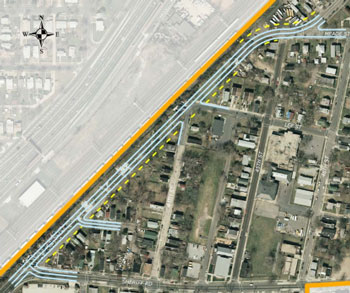DDOT decides not to extend Minnesota Avenue
In 2007, DDOT studied the possibility of connecting Minnesota Avenue, NE between Sheriff Road and Meade Street. Minnesota Avenue runs along the railroad and Orange Line tracks through Ward 7, but with a gap of about a third of a mile. Plans for the area dating back to the 1930s envisioned a connecting segment, but one was never built. Last week, however, DDOT announced its decision not to build the connection.
According to the Environmental Impact Statement Environmental Assessment, the lack of a connection forces traffic to take other local neighborhood streets, especially Meade Street and 44th and 45th Streets. At the time, planners also contemplated using the segment of Minnesota Avenue for the Anacostia Streetcar, which they hoped would run all the way from Bolling or Barry Farm through to the Minnesota Avenue and Deanwood Metro stations.
However, the EIS EA also predicted that 10,000 cars per day would use the new Minnesota Avenue segment, while only reducing the daily volume on 44th and 45th Streets by 1,400 cars per day. Many of the rest would use Minnesota Avenue instead of Kenilworth Avenue/295, on the opposite side of the railroad tracks. The EIS EA doesn’t model the effect on Metro, but adding new roads directly parallel to the Metro line would likely draw at least some commuters to switch from Metro to single-passenger driving. It wouldn’t improve access to Metro, since there’s one station near each end of the gap. And the plan didn’t contain any bicycle lanes or other facilities beyond the standard two-lane arterial with basic sidewalks.
The EIS EA estimated that the project would cost $2.62 or $2.72 million in 2006 dollars, depending on the width of the road, and require taking some private property including demolishing at least one house. It also predicted the project would generate about 60% more carbon monoxide, nitrogen oxide, and other pollutants in the immediate area than the no-build alternative. Since the Deanwood neighborhood almost entirely comprises minority and low-income residents, adding more traffic and pollution would raise significant environmental justice concerns.
Fortunately, DDOT has decided to “close out” the EIS EA by selecting the no-build option. Road connectivity is important to good urban design, but the neighborhood is already a grid. Adding an arterial road along the edge just for its own sake, costing money, adding pollution, and potentially inducing more traffic and lower Metro ridership elsewhere doesn’t make sense.
Instead, DC should invest in Ward 7 through other, better projects. DDOT has reiterated its commitment to the Nannie Helen Burroughs and Minnesota Avenue Great Streets, rehabilitating the Watts Branch trail, and improving alleys and sidewalks throughout the neighborhood. This project reflects an earlier transportation philosophy that prioritized widening and adding arterial routes in and out of the city. It’s time to move away from those plans and focus on improving the quality of life for residents using all modes of travel.

